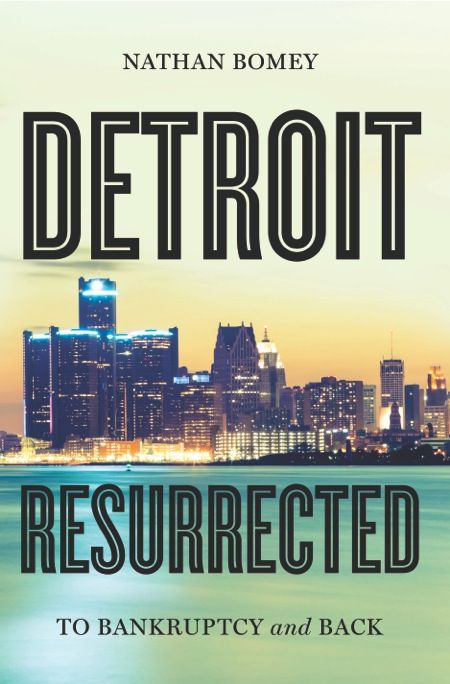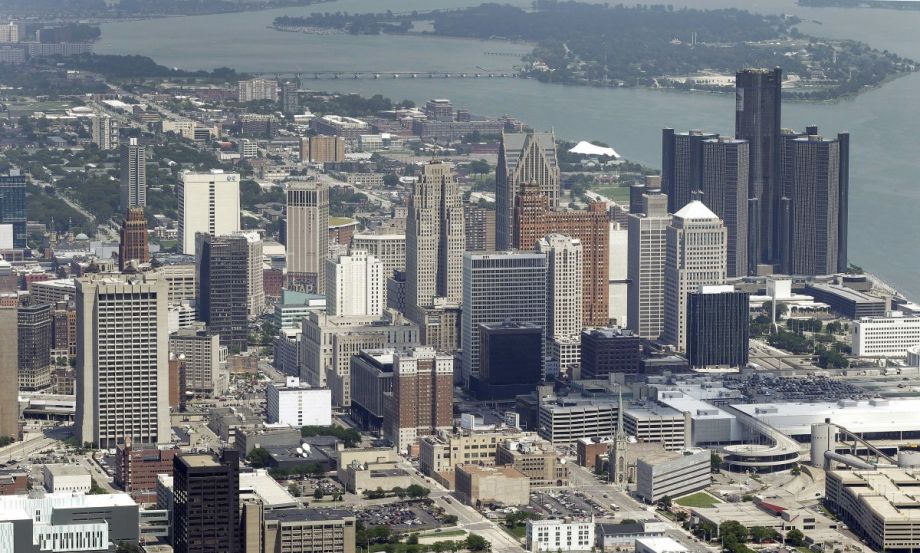“This is the story of what happens when a great American city goes broke.” The plain-stated thesis in the introduction to Nathan Bomey’s new book, Detroit Resurrected: To Bankruptcy and Back, belies its wrenching detail. Despite the glut of news reports published over Detroit’s 18 months in the throes of bankruptcy court, this appears to be the first book to tell the full story of the largest municipal bankruptcy in U.S. history — why Detroit hit its nadir, the complexity of competing interests unleashed by Chapter 9, and how the city has inched its way into the future. And it does so in beautifully distilled prose.
Bomey was one of the journalists covering the bankruptcy for the Detroit Free Press, not only the short hits of day-to-day drama but also in longform features that contextualized the historic upheaval. (Bomey’s now with USA Today.) Detroit Resurrected is a natural extension of that shoe-leather reporting. It’s not a paraphrase of previous news reports; it’s a sweeping narrative built out with exclusive and almost unbelievably candid interviews. Case in point: Emergency Manager Kevyn Orr, who had the power of both mayor and city council in Detroit, on the aggressive tactics of one of the city’s creditors. “Yeah, yeah, yeah,” he says. “Bite me.”
The book demystifies the high-stakes political, legal and financial machinations. While it nods to the on-the-ground experience of Detroiters whose lives are on the line during the bankruptcy, there is ultimately less emphasis on the ordinary experience of residents. There’s also limited material on activists who, from the beginning, opposed Detroit’s emergency management and bankruptcy declaration; they are, in effect, portrayed as just one more hurdle for the powerful insiders to jump over. To a certain extent, this is accurate — the activists meant to be an obstacle — but it also undercuts the good reasons people had to be skeptical. As Bomey himself indicates, there was almost no precedent for the municipal bankruptcy that Detroit went through, and emergency management has hardly been a clear-cut success in other distressed Michigan cities. (I say this as someone who is on record as being cautiously optimistic about emergency management in Detroit.)

Nonetheless, Detroit Resurrected makes a point to draw out the characters — the real people, that is — who shaped the city’s future throughout the bankruptcy. He never wavers from the urgency of every decision along the way, from the devastating debt deal that former Mayor Kwame Kilpatrick made with Wall Street, to the attempt to pit retirees at risk of losing their pensions against the Detroit Institute of Art, whose paintings were at risk of being pilfered by creditors — a false choice, as it turned out.
The book gets into wonky territory, but any urban enthusiast interested in moving beyond “Detroit went bankrupt” stories that frame the narrative more as a metaphor rather than as a tactical, substantive process should pick this one up. Bomey has a newspaperman’s gift for filtering big issues into clear, fast-moving prose, and where there are repetitions, it’s actually a relief: It helps keep the sprawling story straight. (One hopes, though, that the paperback edition will include a “cast of characters” list and a timeline.)
And of course, this story is not just Detroit’s: Too many other cities, counties and states are staggering beneath underfunded pensions, debilitating debt and truncated public services. What choices do they have? As Detroit Resurrected details, right down to the brass tacks, maybe more than they realize.
Its on-sale date is April 25. Until then, here are five insights — with quotes from the book — into Detroit’s bankruptcy that, more than a year after the city emerged from Chapter 9, still amount to revelations.
Don’t blame Coleman Young.
“Some critics believe that the first African-American mayor of Detroit, Coleman Young, a charismatic and polarizing democrat who served from 1974 to 1994, is chiefly to blame for the city’s economic collapse. Even today it’s not uncommon to hear residents of metro Detroit blame Detroit’s demise squarely on Young. While his sharp rhetoric contributed to regional political tension … a close look at Young’s mayoralty reveals a surprisingly frugal reign defined by balanced budgets, an aversion to debt, and wars with unions over legacy costs.
“… His tough, but necessary emphasis on fiscal austerity — which included substantial layoffs and cuts to areas such as recreation — stabilized Detroit’s books. In fact, for several years during his reign, the city’s annual revenue topped its debt load. Young kept insolvency at bay despite the city’s population decline of about a half million residents under his watch …”
Don’t blame political corruption, either.
“The astonishing deterioration in Detroit’s revenue base throughout the second half of the twentieth century was the fundamental source of the city’s financial crisis, obliterating Detroit’s ability to pay for basic services. But it was a slow bleed, gradually draining more and more of the city’s finances over several decades. Toward the end, however, the pace of decline accelerated rapidly, primarily because of the Great Recession and a debt deal that wrecked the city’s budget. Political corruption — often cited as a major contributor to Detroit’s financial demise — played only a small role.”
You can’t run a city like a business — and you can’t bankrupt it like one, either.
“Several mid-size cities in California filed for Chapter 9 bankruptcy after the Great Recession, but in general, municipal bankruptcy was unexplored territory. In fact, it was so rare that case law in Chapter 9 bankruptcy was quite limited, leaving many fundamental questions unanswered, such as the treatment of constitutionally protected pensions.
“Essentially all of the professionals involved in Chapter 9 bankruptcies are veterans of Chapter 11 bankruptcies, in which corporations reorganize their debts. But for good reason Congress established significant differences between municipal and corporate cases. Cities cannot be liquidated, nor can they be split up and sold for parts. So Congress wrote Chapter 9 bankruptcy law to protect cities from being forced to sell assets to satisfy creditors. After bankruptcy, cities must continue to service their residents indefinitely. Police departments must continue protecting the people. Fire departments must continue responding to fires.”
Seems like the Detroit bankruptcy went on forever? It was actually crazy fast.
Detroit filed for bankruptcy on July 18, 2013, and emerged from it on Dec. 10, 2014.
“Before Detroit, most municipal governments floundered in bankruptcy far longer than they anticipated, expending taxpayer dollars on an arduous legal process that yielded few tangible benefits for citizens. The City of San Bernardino, California, for example, filed for bankruptcy in August 2012 and was still stuck in Chapter 9 three years later.
“At the time of its filing, many industry observers believed that if Detroit asked for the court’s protection from creditors, it would take several years to reach a restructuring plan and exit bankruptcy, with attorneys and expensive consultants racking up bills and creditors preventing the city from achieving a restructuring. …
“But many of the previous municipal bankruptcies that tarried were under the control of elected officials who, by law, had to reach a consensus to make major decisions. In Detroit, that was not the case. Governor Rick Snyder had given Kevyn Orr the power to make fast decisions …”
The Grand Bargain — which resolved the bankruptcy by relying on philanthropic contributions to protect the DIA artwork and minimize pension cuts — was not at all a given.
Bomey recounts how Mariam Noland, president of the Community Foundation for Southeast Michigan, reacted when first approached with the proposal:
“’Foundations don’t move fast,’ she was thinking. ‘They don’t fund things that have already happened. They never fund public agencies, like paying pensions. If that’s been done anywhere, I don’t know.’
“She thought the judge’s idea was categorically implausible. ‘Are you crazy?’ she thought.”
And then there was the difficulty of getting political support for the deal in Lansing.
“Orr set out for a Lansing lobbying blitz, but after a first round of meetings with legislators, the outlook for the grand bargain appeared grim.
“’There were legislators who were really pissed off, and I’m the lightning rod,’” Orr said.
“Legislators vented to Orr: ‘What about my district? I’m out here in Lapeer and I don’t get a dime!’ ‘They made their bed. Let them lie in it.’ There was a lot of that,’ he recalled. ‘That didn’t go so well.”

Anna Clark is a journalist in Detroit. Her writing has appeared in Elle Magazine, the New York Times, Politico, the Columbia Journalism Review, Next City and other publications. Anna edited A Detroit Anthology, a Michigan Notable Book. She has been a Fulbright fellow in Nairobi, Kenya and a Knight-Wallace journalism fellow at the University of Michigan. She is also the author of THE POISONED CITY: Flint’s Water and the American Urban Tragedy, published by Metropolitan Books in 2018.
Follow Anna .(JavaScript must be enabled to view this email address)




_600_350_80_s_c1.JPEG)











